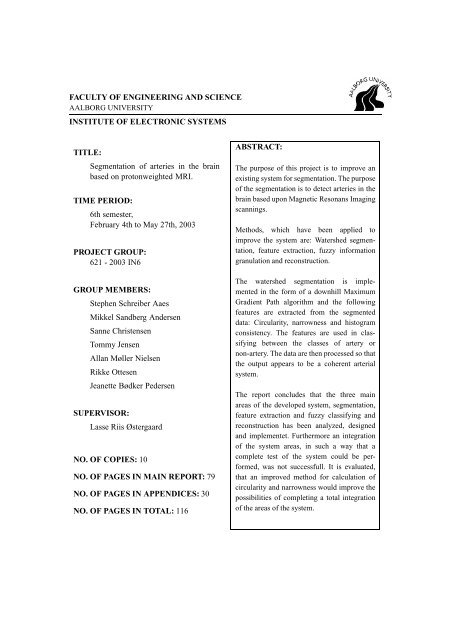Segmentering af arterier i hjernen fra proton
Segmentering af arterier i hjernen fra proton
Segmentering af arterier i hjernen fra proton
You also want an ePaper? Increase the reach of your titles
YUMPU automatically turns print PDFs into web optimized ePapers that Google loves.
FACULTY OF ENGINEERING AND SCIENCE<br />
AALBORG UNIVERSITY<br />
INSTITUTE OF ELECTRONIC SYSTEMS<br />
TITLE:<br />
Segmentation of arteries in the brain<br />
based on <strong>proton</strong>weighted MRI.<br />
TIME PERIOD:<br />
6th semester,<br />
February 4th to May 27th, 2003<br />
PROJECT GROUP:<br />
621 - 2003 IN6<br />
GROUP MEMBERS:<br />
Stephen Schreiber Aaes<br />
Mikkel Sandberg Andersen<br />
Sanne Christensen<br />
Tommy Jensen<br />
Allan Møller Nielsen<br />
Rikke Ottesen<br />
Jeanette Bødker Pedersen<br />
SUPERVISOR:<br />
Lasse Riis Østergaard<br />
NO. OF COPIES: 10<br />
NO. OF PAGES IN MAIN REPORT: 79<br />
NO. OF PAGES IN APPENDICES: 30<br />
NO. OF PAGES IN TOTAL: 116<br />
ABSTRACT:<br />
The purpose of this project is to improve an<br />
existing system for segmentation. The purpose<br />
of the segmentation is to detect arteries in the<br />
brain based upon Magnetic Resonans Imaging<br />
scannings.<br />
Methods, which have been applied to<br />
improve the system are: Watershed segmentation,<br />
feature extraction, fuzzy information<br />
granulation and reconstruction.<br />
The watershed segmentation is implemented<br />
in the form of a downhill Maximum<br />
Gradient Path algorithm and the following<br />
features are extracted from the segmented<br />
data: Circularity, narrowness and histogram<br />
consistency. The features are used in classifying<br />
between the classes of artery or<br />
non-artery. The data are then processed so that<br />
the output appears to be a coherent arterial<br />
system.<br />
The report concludes that the three main<br />
areas of the developed system, segmentation,<br />
feature extraction and fuzzy classifying and<br />
reconstruction has been analyzed, designed<br />
and implementet. Furthermore an integration<br />
of the system areas, in such a way that a<br />
complete test of the system could be performed,<br />
was not successfull. It is evaluated,<br />
that an improved method for calculation of<br />
circularity and narrowness would improve the<br />
possibilities of completing a total integration<br />
of the areas of the system.


